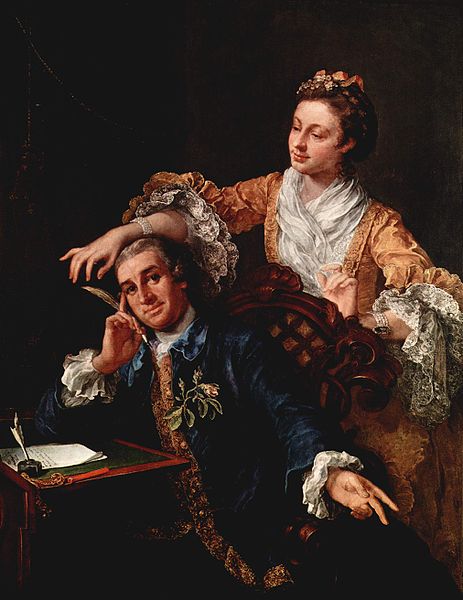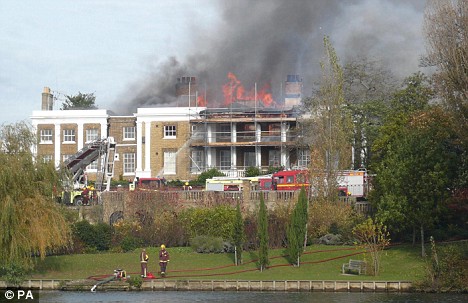A house once lived in by Shakesperean actor David Garrick was damaged in a fire yesterday.
Garrick, who lived from 1717 to 1779, bought the home in 1754.
It is situated in Hampton Court in south west London and it took 70 firefighters to tackle the blaze.....
Pictured: Grade I listed home of Shakespearean actor David Garrick damaged in fire
By Daily Mail Reporter
25th October 2008
Daily Mail

David Garrick with his wife Eva, 1757
A historic building that was once the home of famous 18th century Shakespearean actor David Garrick has been severely damaged by fire.
The blaze ripped through the Grade I listed Garrick's Villa in Hampton Court, south west London, yesterday morning.
The villa's roof completely collapsed during the fire and much of the first and second floors were damaged by the flames. No injuries have been reported.
Enlarge
Inferno: Firefighters attempt to put out the blazing fire at the Grade I listed Garrick's Villa in Hampton, south west London
It took 70 fighters several hours to bring the fire under control, and as night fell, small pockets of flame were still burning.
The London Fire Brigade said the fire was 'severe'.
Spokesman Michael Dent said: 'Our firefighters worked hard to bring the blaze under control.'
'This is going to be a protracted incident. The fire is now under control but the brigade will be at the scene for some time making sure that any remaining small pockets of fire have been extinguished.'
Firefighters were called to the house on the banks of the River Thames at 11.30am.
The building was being refurbished, and was still under scaffolding. The cause of the fire is still under investigation.

Historic: The house was originally built in the middle ages and was modified by Garrick during the 18th century
One eye witness described how the sky filled with smoke, and police cordoned off the area.
Harry Lansdale, a barman at the nearby Kings Arms pub on Hampton Court Road, said: 'The whole road is gridlocked. I've seen loads and loads of police and fire engines driving towards it.
'There's loads of smoke everywhere.'
Garrick bought the house in 1754, and it had retained many of the period features he installed, despite being converted into nine separate flats in the 1960s.
He extensively remodelled the medieval building in the neo-classical style which was then in vogue.
A Greek-style temple to Shakespeare and an orangery were added to the grounds, designed by landscape gardener 'Capability' Brown.
English Heritage described the loss of parts of the building as a 'tragedy' saying the building was of 'national importance'.
The organisation also promised to help with the restoration of the historic house.
Enlarge
Historical importance: The villa was owned by David Garrick, shown here in 1745 playing Richard III (painted by William Hogarth)
Mike Cherry, a volunteer at the Twickenham Museum history centre said the villa was 'an iconic building' whose importance 'couldn't be understated'.
'It's hugely significant because of its association with Garrick,' he said.
'He is such an important figure in theatre, both in acting itself and theatre management, and the building provided an historical link with the man.'
'The news has come as quite a shock,' he added.
Born in 1717, Garrick became one of Britain's most famous actors.
His 35-year career saw him pen more than 20 plays and depict 20 of Shakespeare's most famous roles, including Hamlet, King Lear and Richard III. He also managed the Theatre Royal in Drury Lane for 29 years.
Widely regarded as the father of modern theatre, he pioneered a more realistic acting style, stepping away from the vogue for declaiming lines from plays.
The Garrick Club in Old Covent Garden and the Garrick Theatre in London's Charing Cross Road were both named in his honour.
The actor died in 1779 and was buried in Poet's Corner in Westminster Abbey. After his death, Samuel Johnson wrote: 'His profession made him rich and he made his profession respectable.'
David Garrick
David Garrick was born in Hereford, Herefordshire, in 1717.
Garrick was the third of five children and he was very close to his younger brother George, who would become Garrick's aide for the rest of his life. Playwright and actor, Charles Dibdin, recorded that George, discovering his brother's absence would often inquire "Did David want me?" Upon Garrick's death in 1779, it was noted that George died forty-eight hours later, leading some to speculate that "David wanted him."
Upon his arrival in London in 1737, Garrick and his brother became partners in a wine business with operations in both London and Lichfield with David taking the London operation. The business did not flourish, possibly due to Garrick's distraction by amateur theatricals. Playwright Samuel Foote remarked that he had known Garrick to have only three quarts of vinegar in his cellar and still calling himself a wine merchant.
He made his debut as a professional actor at Ipswich in 1741 in Oroonoko or the Royal Slave, a play by the British dramatist Thomas Southerne.
On 19 October 1741, Garrick appeared in the title role of Richard III at the Theatre Royal, Drury Lane.
The lyrics he penned for Heart of Oak remain, with William Boyce's music, the official March Of the Royal Navy.
Juan de Dios Peza wrote a poem about Garrick, portraying him as a suicidal comedian, Reir Llorando.
Legend has it that he was so engrossed in a performance of Richard III that he was oblivious to a bone fracture, inspiring the theatrical felicitation "Break a leg!"
Garrick would manage the Theatre Royal, Drury Lane until his retirement from management in 1776.
Garrick was the first actor to be granted the honour of being buried in Westminster Abbey, the second being Sir Laurence Olivier in 1989.
dailymail.co.uk
Garrick, who lived from 1717 to 1779, bought the home in 1754.
It is situated in Hampton Court in south west London and it took 70 firefighters to tackle the blaze.....
Pictured: Grade I listed home of Shakespearean actor David Garrick damaged in fire
By Daily Mail Reporter
25th October 2008
Daily Mail

David Garrick with his wife Eva, 1757
A historic building that was once the home of famous 18th century Shakespearean actor David Garrick has been severely damaged by fire.
The blaze ripped through the Grade I listed Garrick's Villa in Hampton Court, south west London, yesterday morning.
The villa's roof completely collapsed during the fire and much of the first and second floors were damaged by the flames. No injuries have been reported.
Enlarge

Inferno: Firefighters attempt to put out the blazing fire at the Grade I listed Garrick's Villa in Hampton, south west London
It took 70 fighters several hours to bring the fire under control, and as night fell, small pockets of flame were still burning.
The London Fire Brigade said the fire was 'severe'.
Spokesman Michael Dent said: 'Our firefighters worked hard to bring the blaze under control.'
'This is going to be a protracted incident. The fire is now under control but the brigade will be at the scene for some time making sure that any remaining small pockets of fire have been extinguished.'
Firefighters were called to the house on the banks of the River Thames at 11.30am.
The building was being refurbished, and was still under scaffolding. The cause of the fire is still under investigation.

Historic: The house was originally built in the middle ages and was modified by Garrick during the 18th century
One eye witness described how the sky filled with smoke, and police cordoned off the area.
Harry Lansdale, a barman at the nearby Kings Arms pub on Hampton Court Road, said: 'The whole road is gridlocked. I've seen loads and loads of police and fire engines driving towards it.
'There's loads of smoke everywhere.'
Garrick bought the house in 1754, and it had retained many of the period features he installed, despite being converted into nine separate flats in the 1960s.
He extensively remodelled the medieval building in the neo-classical style which was then in vogue.
A Greek-style temple to Shakespeare and an orangery were added to the grounds, designed by landscape gardener 'Capability' Brown.
English Heritage described the loss of parts of the building as a 'tragedy' saying the building was of 'national importance'.
The organisation also promised to help with the restoration of the historic house.
Enlarge

Historical importance: The villa was owned by David Garrick, shown here in 1745 playing Richard III (painted by William Hogarth)
Mike Cherry, a volunteer at the Twickenham Museum history centre said the villa was 'an iconic building' whose importance 'couldn't be understated'.
'It's hugely significant because of its association with Garrick,' he said.
'He is such an important figure in theatre, both in acting itself and theatre management, and the building provided an historical link with the man.'
'The news has come as quite a shock,' he added.
Born in 1717, Garrick became one of Britain's most famous actors.
His 35-year career saw him pen more than 20 plays and depict 20 of Shakespeare's most famous roles, including Hamlet, King Lear and Richard III. He also managed the Theatre Royal in Drury Lane for 29 years.
Widely regarded as the father of modern theatre, he pioneered a more realistic acting style, stepping away from the vogue for declaiming lines from plays.
The Garrick Club in Old Covent Garden and the Garrick Theatre in London's Charing Cross Road were both named in his honour.
The actor died in 1779 and was buried in Poet's Corner in Westminster Abbey. After his death, Samuel Johnson wrote: 'His profession made him rich and he made his profession respectable.'
David Garrick
David Garrick was born in Hereford, Herefordshire, in 1717.
Garrick was the third of five children and he was very close to his younger brother George, who would become Garrick's aide for the rest of his life. Playwright and actor, Charles Dibdin, recorded that George, discovering his brother's absence would often inquire "Did David want me?" Upon Garrick's death in 1779, it was noted that George died forty-eight hours later, leading some to speculate that "David wanted him."
Upon his arrival in London in 1737, Garrick and his brother became partners in a wine business with operations in both London and Lichfield with David taking the London operation. The business did not flourish, possibly due to Garrick's distraction by amateur theatricals. Playwright Samuel Foote remarked that he had known Garrick to have only three quarts of vinegar in his cellar and still calling himself a wine merchant.
He made his debut as a professional actor at Ipswich in 1741 in Oroonoko or the Royal Slave, a play by the British dramatist Thomas Southerne.
On 19 October 1741, Garrick appeared in the title role of Richard III at the Theatre Royal, Drury Lane.
The lyrics he penned for Heart of Oak remain, with William Boyce's music, the official March Of the Royal Navy.
Juan de Dios Peza wrote a poem about Garrick, portraying him as a suicidal comedian, Reir Llorando.
Legend has it that he was so engrossed in a performance of Richard III that he was oblivious to a bone fracture, inspiring the theatrical felicitation "Break a leg!"
Garrick would manage the Theatre Royal, Drury Lane until his retirement from management in 1776.
Garrick was the first actor to be granted the honour of being buried in Westminster Abbey, the second being Sir Laurence Olivier in 1989.
dailymail.co.uk